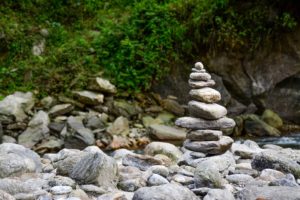Hello fellow readers, What a delight to help a lifelong friend plan a more sustainable backyard by removing turf and putting in a lawn alternative and native plants to nurture nature. Part of the criteria for a grant, which will fund some of the project’s expenses, is to include a rock garden with a swale to manage runoff which led to a discussion about the etiquette of pilfering rocks from the wilderness.

Visiting our dorm at The Fashion Institute of Technology. Hint: baby Whitney is now in her mid-30, and our hair is not as big. :^)
Linda, who I lovingly call “Lindy-poo,” were roomies in college. She’s working with the Municipal Water District of Orange County, California, which has a Turf Removal Program with rebates for participants. And by doing so, they tout residents will use 70 percent less water. They have template designs you can use, but delightfully Linda asked Mary instead.
We discussed having a seating rock amongst the pea gravel and swale, much like the dry river beds we create in our neck of the woods to manage interim flooding from storm events—decorating them with boulders and pops of native plants. I forewarned that beautiful boulders and pea gravel could be pricey. Linda suggested having a family outing and picnic and harvesting rocks from the wilderness afterward, leading to a friendly banter.
Imagine if everyone snagged rocks.

A pollinator-friendly lawn alternative designed for Stephanie in Denville, NJ
Imagine if everyone snagged rocks. Then there’s the issue of disturbing wildlife that lives below stones. Of course, you could drop the rock back in position if you find an ant colony below. Recalling one I disturbed when moving a garden pot. They were the tiny ants that invaded our home in spring. I felt terrible watching each ant scatter carrying an egg and was betwixt and between to allow them to move into the kitchen or partake in Mom’s remedy. The latter won, and I poured boiling water on the critters. Writing this still brings sadness. Ants are pollinators, after all.
Linda said, “you can’t take anything from the beaches here, and steeling black lava stones in Hawaii put a curse on you.” So much so that folks mail them back to park rangers pleading they put them back where they belong.

Photo by Sudarshan Bhat on Unsplash
The craze of Stacked Stones
Our chat led to the stacked stones at parks and hiking trails. Most fall for the fun of rock stacking to see how many they can stack. Or, folks stack them for the meditative aspects calling them “stone balancing” or “prayer stone stacks.”
Also called cairns, they served as burial memorials in prehistoric times. And they warned sailors of jagged shores before the lighthouse came to be. Now they mark trails, especially in remote places such as mountain summits, so kicking them down could be dangerous for those counting on them.
They say due to social media, there’s a craze for creating stacks of stones, essentially littering parks and trails. Imagine the mess of things if everyone piled rocks. Besides, it contradicts the outdoor ethics of “Leave No Trace.” Carry out what you carry in, do not disturb nature, and leave behind only footprints.

James’ Inuksuk was made into a water feature—link to Planning an Alpine Garden.
But stacked stones can have a beautiful place in your landscape. And they are deer-proof! Though bears can roll them to find the grubs below.
Inuksuks are artful stacks of stones that resemble people. Historically, the peoples of the Artic regions in North America used them for navigation. A delightful client built one to sit on a crevice of a massive boulder outcropping to overlook a gentle streaming water feature we created below.
Back to the etiquette of pilfering rocks
According to the USDA Forest Service, recreational mineral collecting is allowed without a permit for personal use up to ten pounds of common stones on the surface – no digging permitted. And no vertebrate fossils, shark teeth, or old civilization remnants can be removed. Some areas are designated wilderness or sensitive areas where collecting is illegal. They suggest checking with the Bureau of Land Management to find out where you plan to gather samples.
Did you know that rock collecting or amateur geology is also called rockhounding? It sounds gluttonous (rockhounding), but gathering a few rocks in a non-piggish way seems innocent. But sadly, people can be greedy, or commercial operations take resources for profit, much like poaching animals. So rules are made.
So, Lindy-poo, now that I’ve shared this story, they’ll know it’s you if you overdo (smile) —and please only pilfer with permission.
Garden Dilemmas? AskMaryStone@gmail.com and on your favorite Podcast App.
There’s more to this story in the Garden Dilemmas Podcast:
You’ll enjoy the amazing art of Mother Nature—Tripod Rock
Helpful Links:
Bureau of Land Management – About Mining and Minerals
Link to USDA Forest Service Recreational Mineral Collecting
Municipal Water District of Orange County, California – Friendly Landscapes



Great article and very informative!
I knew about cairns and love the idea of adding one to my garden. I’m planning to be a rock hound…
Thank you, Rosemary; I am sure you’ll be kind to Mother Nature as you pilfer rocks :^) Appreciate you reading my column, Mary